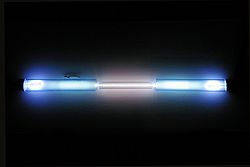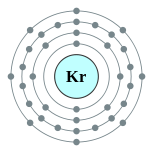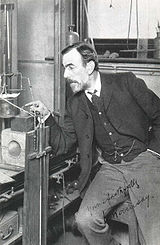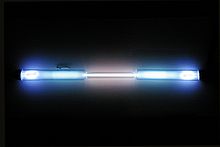
Krypton
About this schools Wikipedia selection
SOS Children have produced a selection of wikipedia articles for schools since 2005. SOS mothers each look after a a family of sponsored children.
| Krypton | ||||||||||||||||||||||||||||||||||||||||||||||||||||||||||||||||||||||
|---|---|---|---|---|---|---|---|---|---|---|---|---|---|---|---|---|---|---|---|---|---|---|---|---|---|---|---|---|---|---|---|---|---|---|---|---|---|---|---|---|---|---|---|---|---|---|---|---|---|---|---|---|---|---|---|---|---|---|---|---|---|---|---|---|---|---|---|---|---|---|
|
36Kr
|
||||||||||||||||||||||||||||||||||||||||||||||||||||||||||||||||||||||
|
||||||||||||||||||||||||||||||||||||||||||||||||||||||||||||||||||||||
| Appearance | ||||||||||||||||||||||||||||||||||||||||||||||||||||||||||||||||||||||
colorless gas, exhibiting a whitish glow in a high electric field Spectral lines of krypton |
||||||||||||||||||||||||||||||||||||||||||||||||||||||||||||||||||||||
| General properties | ||||||||||||||||||||||||||||||||||||||||||||||||||||||||||||||||||||||
| Name, symbol, number | krypton, Kr, 36 | |||||||||||||||||||||||||||||||||||||||||||||||||||||||||||||||||||||
| Pronunciation | / ˈ k r ɪ p t ɒ n / KRIP-ton | |||||||||||||||||||||||||||||||||||||||||||||||||||||||||||||||||||||
| Element category | noble gases | |||||||||||||||||||||||||||||||||||||||||||||||||||||||||||||||||||||
| Group, period, block | 18 (noble gases), 4, p | |||||||||||||||||||||||||||||||||||||||||||||||||||||||||||||||||||||
| Standard atomic weight | 83.798 | |||||||||||||||||||||||||||||||||||||||||||||||||||||||||||||||||||||
| Electron configuration | [Ar] 3d10 4s2 4p6 2, 8, 18, 8 |
|||||||||||||||||||||||||||||||||||||||||||||||||||||||||||||||||||||
| History | ||||||||||||||||||||||||||||||||||||||||||||||||||||||||||||||||||||||
| Discovery | William Ramsay and Morris Travers (1898) | |||||||||||||||||||||||||||||||||||||||||||||||||||||||||||||||||||||
| First isolation | William Ramsay and Morris Travers (1898) | |||||||||||||||||||||||||||||||||||||||||||||||||||||||||||||||||||||
| Physical properties | ||||||||||||||||||||||||||||||||||||||||||||||||||||||||||||||||||||||
| Phase | gas | |||||||||||||||||||||||||||||||||||||||||||||||||||||||||||||||||||||
| Density | (0 °C, 101.325 kPa) 3.749 g/L |
|||||||||||||||||||||||||||||||||||||||||||||||||||||||||||||||||||||
| Liquid density at b.p. | 2.413 g·cm−3 | |||||||||||||||||||||||||||||||||||||||||||||||||||||||||||||||||||||
| Melting point | 115.79 K, -157.36 °C, -251.25 °F | |||||||||||||||||||||||||||||||||||||||||||||||||||||||||||||||||||||
| Boiling point | 119.93 K, -153.22 °C, -244.12 °F | |||||||||||||||||||||||||||||||||||||||||||||||||||||||||||||||||||||
| Triple point | 115.775 K (-157°C), 73.2 kPa | |||||||||||||||||||||||||||||||||||||||||||||||||||||||||||||||||||||
| Critical point | 209.41 K, 5.50 MPa | |||||||||||||||||||||||||||||||||||||||||||||||||||||||||||||||||||||
| Heat of fusion | 1.64 kJ·mol−1 | |||||||||||||||||||||||||||||||||||||||||||||||||||||||||||||||||||||
| Heat of vaporization | 9.08 kJ·mol−1 | |||||||||||||||||||||||||||||||||||||||||||||||||||||||||||||||||||||
| Molar heat capacity | 5 R/2 = 20.786 J·mol−1·K−1 | |||||||||||||||||||||||||||||||||||||||||||||||||||||||||||||||||||||
| Vapor pressure | ||||||||||||||||||||||||||||||||||||||||||||||||||||||||||||||||||||||
|
||||||||||||||||||||||||||||||||||||||||||||||||||||||||||||||||||||||
| Atomic properties | ||||||||||||||||||||||||||||||||||||||||||||||||||||||||||||||||||||||
| Oxidation states | 2, 1, 0 | |||||||||||||||||||||||||||||||||||||||||||||||||||||||||||||||||||||
| Electronegativity | 3.00 (Pauling scale) | |||||||||||||||||||||||||||||||||||||||||||||||||||||||||||||||||||||
| Ionization energies | 1st: 1350.8 kJ·mol−1 | |||||||||||||||||||||||||||||||||||||||||||||||||||||||||||||||||||||
| 2nd: 2350.4 kJ·mol−1 | ||||||||||||||||||||||||||||||||||||||||||||||||||||||||||||||||||||||
| 3rd: 3565 kJ·mol−1 | ||||||||||||||||||||||||||||||||||||||||||||||||||||||||||||||||||||||
| Covalent radius | 116±4 pm | |||||||||||||||||||||||||||||||||||||||||||||||||||||||||||||||||||||
| Van der Waals radius | 202 pm | |||||||||||||||||||||||||||||||||||||||||||||||||||||||||||||||||||||
| Miscellanea | ||||||||||||||||||||||||||||||||||||||||||||||||||||||||||||||||||||||
| Crystal structure | cubic face-centered | |||||||||||||||||||||||||||||||||||||||||||||||||||||||||||||||||||||
| Magnetic ordering | diamagnetic | |||||||||||||||||||||||||||||||||||||||||||||||||||||||||||||||||||||
| Thermal conductivity | 9.43×10-3 W·m−1·K−1 | |||||||||||||||||||||||||||||||||||||||||||||||||||||||||||||||||||||
| Speed of sound | (gas, 23 °C) 220, (liquid) 1120 m·s−1 | |||||||||||||||||||||||||||||||||||||||||||||||||||||||||||||||||||||
| CAS registry number | 7439-90-9 | |||||||||||||||||||||||||||||||||||||||||||||||||||||||||||||||||||||
| Most stable isotopes | ||||||||||||||||||||||||||||||||||||||||||||||||||||||||||||||||||||||
| Main article: Isotopes of krypton | ||||||||||||||||||||||||||||||||||||||||||||||||||||||||||||||||||||||
|
||||||||||||||||||||||||||||||||||||||||||||||||||||||||||||||||||||||
Krypton (from Greek: κρυπτός kryptos "the hidden one") is a chemical element with symbol Kr and atomic number 36. It is a member of group 18 (noble gases) elements. A colorless, odorless, tasteless noble gas, krypton occurs in trace amounts in the atmosphere, is isolated by fractionally distilling liquified air, and is often used with other rare gases in fluorescent lamps. Krypton is inert for most practical purposes.
Krypton, like the other noble gases, can be used in lighting and photography. Krypton light has a large number of spectral lines, and krypton's high light output in plasmas allows it to play an important role in many high-powered gas lasers (krypton ion and excimer lasers), which pick out one of the many spectral lines to amplify. There is also a specific krypton fluoride laser. The high power and relative ease of operation of krypton discharge tubes caused (from 1960 to 1983) the official length of a meter to be defined in terms of the 605 nm (red-orange) spectral line of krypton-86.
History
Krypton was discovered in Britain in 1898 by Sir William Ramsay, a Scottish chemist, and Morris Travers, an English chemist, in residue left from evaporating nearly all components of liquid air. Neon was discovered by a similar procedure by the same workers just a few weeks later. William Ramsay was awarded the 1904 Nobel Prize in Chemistry for discovery of a series of noble gases, including krypton.
In 1960, an international agreement defined the meter in terms of wavelength of light emitted by the krypton-86 isotope (wavelength of 605.78 nanometers). This agreement replaced the longstanding standard meter located in Paris, which was a metal bar made of a platinum-iridium alloy (the bar was originally estimated to be one ten-millionth of a quadrant of the Earth's polar circumference), and was itself replaced by a definition based on the speed of light — a fundamental physical constant. However, in 1927, the International Conference on Weights and Measures had redefined the meter in terms of a red cadmium spectral line (1 m = 1,553,164.13 wavelengths). In October 1983, the same bureau defined the meter as the distance that light travels in a vacuum during 1/299,792,458 s.
Characteristics
Krypton is characterized by several sharp emission lines ( spectral signatures) the strongest being green and yellow. It is one of the products of uranium fission. Solidified krypton is white and crystalline with a face-centered cubic crystal structure, which is a common property of all noble gases (except helium, with a hexagonal close-packed crystal structure).
Isotopes
Naturally occurring krypton is made of six stable isotopes. In addition, about thirty unstable isotopes and isomers are known. 81Kr, the product of atmospheric reactions, is produced with the other naturally occurring isotopes of krypton. Being radioactive, it has a half-life of 230,000 years. Krypton is highly volatile when it is near surface waters but 81Kr has been used for dating old (50,000–800,000 years) groundwater.
85Kr is an inert radioactive noble gas with a half-life of 10.76 years. It is produced by the fission of uranium and plutonium, such as in nuclear bomb testing and nuclear reactors. 85Kr is released during the reprocessing of fuel rods from nuclear reactors. Concentrations at the North Pole are 30% higher than at the South Pole due to convective mixing.
Chemistry
Like the other noble gases, krypton is chemically unreactive. However, following the first successful synthesis of xenon compounds in 1962, synthesis of krypton difluoride (KrF2) was reported in 1963. In the same year, KrF4 was reported by Grosse, et al., but was subsequently shown to be a mistaken identification. There are also unverified reports of a barium salt of a krypton oxoacid. ArKr+ and KrH+ polyatomic ions have been investigated and there is evidence for KrXe or KrXe+.
Compounds with krypton bonded to atoms other than fluorine have also been discovered. The reaction of KrF2 with B(OTeF5)3 produces an unstable compound, Kr(OTeF5)2, that contains a krypton-oxygen bond. A krypton-nitrogen bond is found in the cation [HC≡N–Kr–F]+
, produced by the reaction of KrF2 with [HC≡NH]+
[AsF−
6] below −50 °C. HKrCN and HKrC≡CH (krypton hydride-cyanide and hydrokryptoacetylene) were reported to be stable up to 40 K.
Natural occurrence
The Earth has retained all of the noble gases that were present at its formation except for helium. Krypton's concentration in the atmosphere is about 1 ppm. It can be extracted from liquid air by fractional distillation. The amount of krypton in space is uncertain, as the amount is derived from the meteoric activity and that from solar winds. The first measurements suggest an overabundance of krypton in space.
Applications
Krypton's multiple emission lines make ionized krypton gas discharges appear whitish, which in turn makes krypton-based bulbs useful in photography as a brilliant white light source. Krypton is thus used in some types of photographic flashes used in high speed photography. Krypton gas is also combined with other gases to make luminous signs that glow with a bright greenish-yellow light.
Krypton mixes with argon as the fill gas of energy saving fluorescent lamps. This reduces their power consumption. Unfortunately this also reduces their light output and raises their cost. Krypton costs about 100 times as much as argon. Krypton (along with xenon) is also used to fill incandescent lamps to reduce filament evaporation and allow higher operating temperatures to be used for the filament. A brighter light results which contains more blue than conventional lamps.
Krypton's white discharge is often used to good effect in colored gas discharge tubes, which are then simply painted or stained in other ways to allow the desired colour (for example, "neon" type advertising signs where the letters appear in differing colors are often entirely krypton-based). Krypton is also capable of much higher light power density than neon in the red spectral line region, and for this reason, red lasers for high-power laser light-shows are often krypton lasers with mirrors which select out the red spectral line for laser amplification and emission, rather than the more familiar helium-neon variety, which could never practically achieve the multi-watt red laser light outputs needed for this application.
Krypton has an important role in production and usage of the krypton fluoride laser. The laser has been important in the nuclear fusion energy research community in confinement experiments. The laser has high beam uniformity, short wavelength, and the ability to modify the spot size to track an imploding pellet.
In experimental particle physics, liquid krypton is used to construct quasi-homogeneous electromagnetic calorimeters. A notable example is the calorimeter of the NA48 experiment at CERN containing about 27 tonnes of liquid krypton. This usage is rare, since the cheaper liquid argon is typically used. The advantage of krypton over argon is a small Molière radius of 4.7 cm, which allows for excellent spatial resolution and low degree of overlapping. The other parameters relevant for calorimetry application are: radiation length of X0=4.7 cm, density of 2.4 g/cm3.
The sealed spark gap assemblies contained in ignition exciters used in some older jet engines contain a very small amount of Krypton-85 to obtain consistent ionization levels and uniform operation.
Krypton-83 has application in magnetic resonance imaging (MRI) for imaging airways. In particular, it may be used to distinguish between hydrophobic and hydrophilic surfaces containing an airway.
Although xenon has potential for use in computed tomography (CT) to assess regional ventilation, its anesthetic properties limit its fraction in the breathing gas to 35%. The use of a breathing mixture containing 30% xenon and 30% krypton is comparable in effectiveness for CT to a 40% xenon fraction, while avoiding the unwanted effects of a high fraction xenon gas.
Precautions
Krypton is considered to be a non-toxic asphyxiant. Krypton has a narcotic potency seven times greater than air, so breathing a gas containing 50% krypton and 50% air would cause narcosis similar to breathing air at four times atmospheric pressure. This would be comparable to scuba diving at a depth of 30 m (100 ft) (see nitrogen narcosis) and potentially could affect anyone breathing it. Nevertheless, that mixture would contain only 10% oxygen and hypoxia would be a greater concern.






